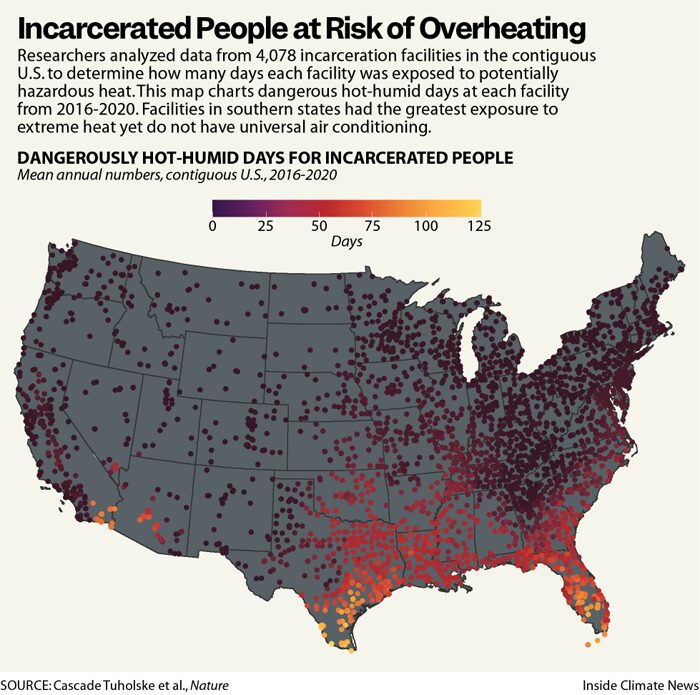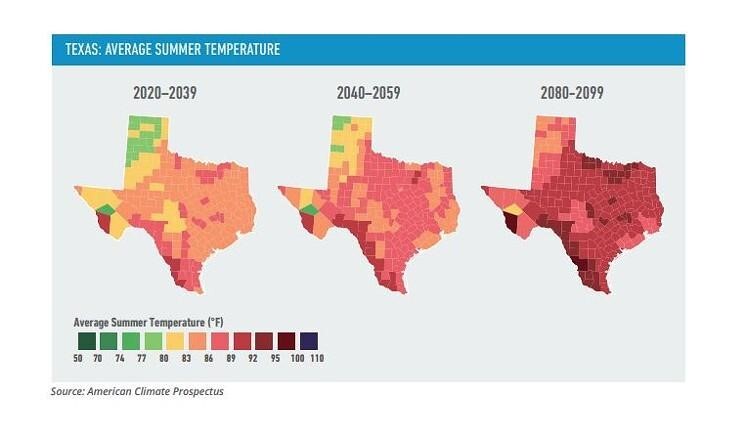Hell On Earth: Extreme Heat & Human Rights in Texas Prisons

Authored by Dream.Org
Sweltering Summers and Searing Injustice: The Human Toll of Extreme Heat in Texas Prisons
As July scorches Texas with extraordinary heat, the situation for incarcerated individuals has become even more dire. Hurricane Beryl recently left nearly 2.1 million people without power. With temperatures soaring above 95° Fahrenheit and average humidity levels of 71%, the heat index (how it feels) averages between 105° - 120° Fahrenheit daily, the need for reform in Texas prisons is more urgent than ever.
Approximately 70% of Texas’ prisons lack air conditioning in living areas which means temperatures inside cells can soar to extreme and deadly levels during scorching Texas summers. Recent lawsuits and advocacy efforts have brought increased attention to this issue, highlighting the urgent need for solutions to protect vulnerable populations.
As climate change intensifies heat waves across the state, policymakers grapple with the complex challenges of upgrading aging infrastructure, implementing effective heat mitigation strategies, and balancing security concerns with humane living conditions in Texas correctional facilities.
The Texas Department of Criminal Justice (TDCJ) has and continues to experience critical staffing levels due to ongoing hiring and retention issues, despite recent efforts to address the problem. The staffing shortages have resulted in increased security risks for both staff and the public, and the situation is expected to continue as the inmate population is projected to grow in the next few years. The TDCJ has established various programs to boost recruitment and retention, such as salary increases, career development opportunities, and employee benefits, but hiring and turnover remain significant challenges.
A Legacy of Suffering: Historical Context
The Texas prison system's history is a stark reflection of the state's complex racial and economic legacy. Established in 1848, the system's early facilities rose from the ashes of slave plantations, a chilling harbinger of the injustices to come. In the post-Civil War era, Texas, like many Southern states, found a sinister loophole to perpetuate slavery: convict leasing. This system, the largest in the nation, saw prisoners—predominantly Black—leased to private contractors, enduring brutal conditions that often proved fatal.
When convict leasing was finally abolished in 1910, the state simply purchased the plantations and continued to profit from incarcerated labor, a practice that persisted until the 1950s. This era saw the beginning of reform, but true change was slow in coming. The landmark Ruiz v. Estelle case (1972-1980) forced the system to address its myriad issues, from overcrowding to guard brutality.
Yet, even as reforms were implemented, new challenges emerged. The tough-on-crime policies of the 1990s led to a massive expansion of the prison population, disproportionately affecting communities of color. New prisons sprouted across rural Texas, becoming linchpins of local economies—a modern echo of the system's exploitative roots.
Throughout this tumultuous history, one constant has been the punishing Texas heat. To this day, about 70% of Texas prisons lack air conditioning in living areas, a situation that grows more dire as climate change intensifies summer temperatures. Despite mounting pressure from advocacy groups and lawsuits, progress on this front remains frustratingly slow, much like the system's long journey toward justice and rehabilitation.
This narrative of the Texas prison system—from plantation to penitentiary, from convict leasing to mass incarceration—continues to evolve, shaped by the enduring forces of racial inequality, economic exploitation, and shifting societal attitudes towards crime and punishment.
The Human Cost of Extreme Heat
The brutal Texas summers are not just uncomfortable but potentially fatal. Formerly incarcerated people recount harrowing experiences of cell temperatures measuring up to 149° Fahrenheit. A study by Julie Skarha from Brown University found that an average of 14 deaths per year are linked to extreme heat in Texas prisons, despite the Texas Department of Criminal Justice (TDCJ) claiming no heat-related deaths since 2012. The heat exacerbates existing health conditions and can lead to renal diseases, cardiovascular issues, respiratory illnesses, and even suicides.

One man, Bernie Tiede, suffered a medical crisis in a Huntsville cell that reached over 110 degrees. His story, among others, underscores the urgent need for action. Despite court orders for his relocation to an air-conditioned cell, the system's unpredictability means his safety is not guaranteed year to year.
A Personal Account: Living in an Oven
Watch and listen to the formerly incarcerated women of the Lioness: Justice Impacted Women’s Alliance (JIWA) discuss the extreme heat and extraordinary challenges in the Texas prison system.
Khaàliq Shakur, incarcerated at the Dr. Lane Murray Unit in Gatesville, likened his experience to being "cooked alive." With temperatures inside his prison reaching as high as 130 degrees, Shakur described desperate measures people take to cool down, such as wrapping wet towels around their bodies and using malfunctioning state-issued tablets to distract from the unbearable heat.
Kwaneta Harris, also incarcerated at the Dr. Lane Murray Unit, shared the tragic story of Elizabeth Hagerty, a fellow inmate who died after repeatedly being returned to her bunk despite complaining of chest pains. Harris described the relentless heat in solitary confinement, where she is denied ice and adequate ventilation, and how she must pour tepid tap water on the cement floor to find some relief. Harris's toothpaste turns to liquid, and soda cans burst from the heat.
Lisa Bell, a formerly incarcerated woman, shared her experience with high blood pressure exacerbated by the heat. “Surviving the summers was a constant battle. The heat was unbearable, and the lack of cool air made it hard to breathe, let alone live with any dignity,” she recounted. Her ongoing health issues highlight the long-term impact of extreme heat on formerly incarcerated people, underscoring the necessity for immediate action.
Legal Battles and Advocacy
Advocacy groups and legal battles have intensified in recent years. In April 2024, four nonprofit organizations filed a lawsuit against TDCJ, arguing that the lack of air conditioning constitutes cruel and unusual punishment. The plaintiffs seek a federal mandate to keep prison temperatures below 85 degrees, a standard already required for Texas jails and federal prisons.

“What is truly infuriating is the failure to acknowledge that everyone in the system — all 130,000 prisoners — are at direct risk of being impacted by something that has a simple solution that has been around since the 1930s, and that is air conditioning,” attorney Jeff Edwards emphasized. This sentiment is echoed by many, including State Rep. Carl Sherman, who criticized the state’s reluctance to fund necessary cooling measures despite a record budget surplus.
Impact on Staff and Security
The extreme heat also affects prison staff, who endure the same oppressive conditions as the incarcerated individuals. Clifton Buchanan, deputy director of AFSCME Texas Correctional Employees Council 907, vividly describes the working conditions: "Imagine going up and downstairs at a football stadium in the heat of the day, while wearing a coat. That is what these extreme conditions for staff are like. Officers work 16 to 18 hours a day, six to eight days straight. Standing on cement floors, with no place to sit or rest in this extreme heat”
Correctional officers must work in heavy uniforms, perform physical tasks, and manage heightened tensions exacerbated by the heat. The current mitigation measures are inadequate, as Buchanan points out: "The solution can't just be [to] drink more fluids, especially when staff may not even get a restroom break during their shifts."
The heat's impact on staff health and job performance is significant. In 2023, the Texas Department of Criminal Justice (TDCJ) reported 35 heat-related illnesses among staff, compared to 14 among prisoners, suggesting that staff may be more vulnerable to heat-related health issues. This harsh environment contributes to high turnover rates and absenteeism, with excessive heat cited as a major reason why corrections staff quit and call in sick.
Buchanan emphasizes the urgent need for improved working conditions: "In law enforcement, where staff are tasked with working physically demanding and dangerous jobs, we must do everything we can do to provide them with the best working conditions possible. We hope we can continue to work with legislators on improving these dehumanizing working conditions." The lack of climate control affects both the incarcerated and staff, creating a dangerous environment for everyone in the Texas prison system. Addressing this issue is crucial not only for the well-being of incarcerated individuals but also for maintaining a stable and effective workforce in these facilities.
Insufficient Measures and the Call for Change
TDCJ’s current heat mitigation strategies, such as providing ice water and allowing the purchase of fans and cooling towels, are woefully inadequate. Incarcerated individuals often resort to desperate measures, like flooding their cells and lying in the water to cool down. Michele Deitch from the University of Texas at Austin highlights that these conditions lead to more violence and use of force, further destabilizing the prison environment.
Despite these challenges, there is hope. Recent research and advocacy have led to increased awareness and pressure on policymakers. The Texas House proposed $545 million for air conditioning in prisons, though the Senate did not approve it. Advocates argue that the cost of installing air conditioning would ultimately be lower than the legal fees and health costs associated with heat-related deaths and illnesses.
The extreme heat in Texas prisons is not just a matter of comfort but a severe human rights issue. The recent power outages caused by Hurricane Beryl have further highlighted the vulnerability of all people to extreme weather events, especially the incarcerated. It is time for policymakers to act with compassion and prioritize the health and safety of all individuals in the Texas prison system.
By addressing these issues, we will create a more just and humane correctional system. The solution is clear and attainable: installing air conditioning in all prison living areas. This simple yet crucial change would protect the lives of incarcerated individuals and staff, reduce healthcare costs, and fulfill our moral obligation to treat all individuals with dignity and respect.
Every voice counts in the fight for humane conditions in our prison system. Together, we can end this cruel and unusual punishment and uphold the dignity of all individuals, regardless of their circumstances.
Sign the petition and tell Congress to pass federal legislation establishing nationwide standards for temperature control in correctional facilities.
Thank you for taking the time to read this article and become informed about the inhumane conditions and callous indifference suffered by so many in our prison systems. Becoming informed is the first step on your journey to make real, positive change happen in our communities. Your voice matters, and it matters a lot. We can’t make a difference without you.
